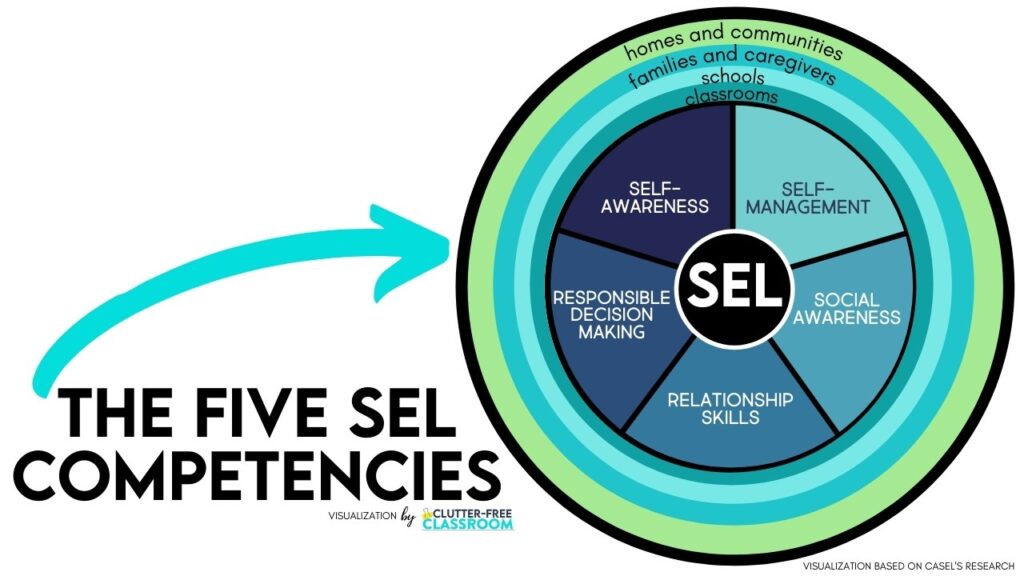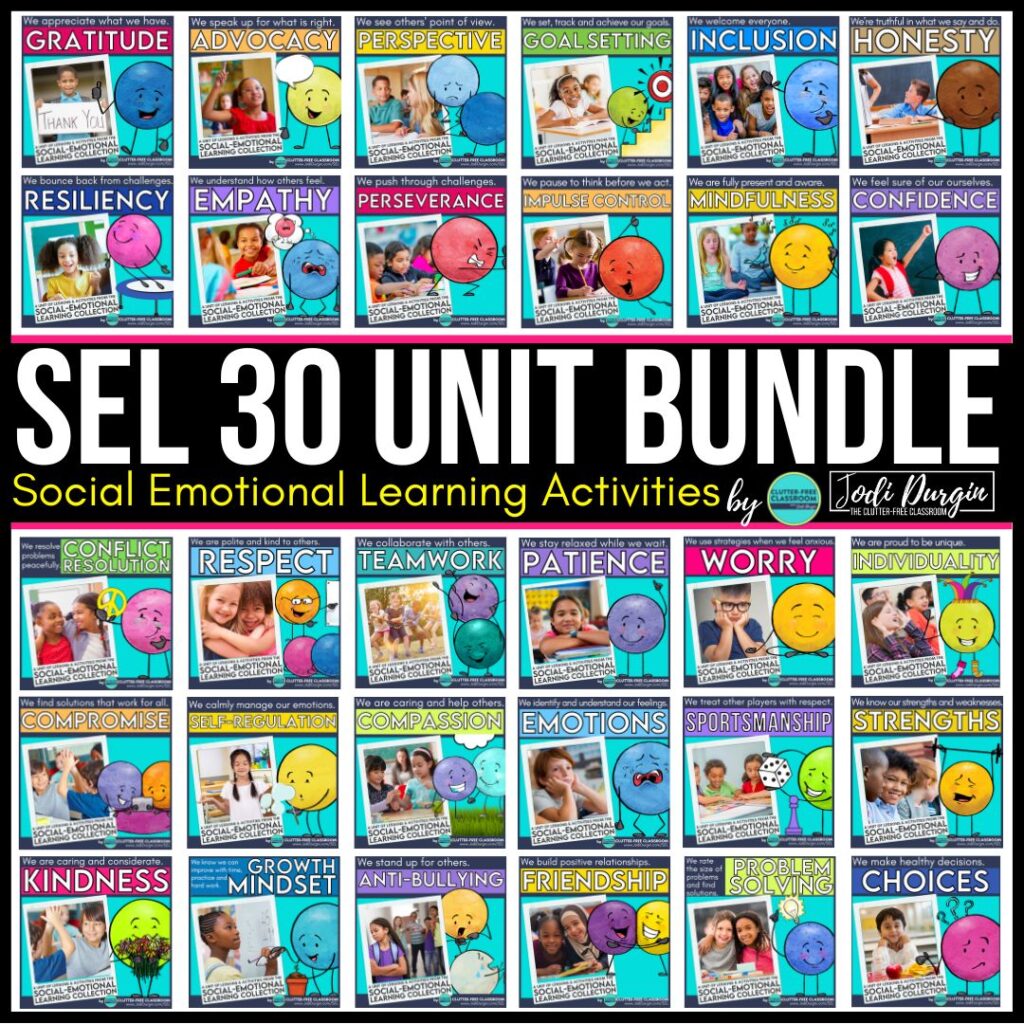Social emotional learning (SEL) is an essential part of elementary education in this day and age. Some argue that SEL for kids might be even more important than content areas like math and reading. SEL in the classroom can look differently across grade levels and classrooms. However, it all aligns with CASEL’s SEL framework. This framework is made up of 5 core competencies: self-awareness, self-management, responsible decision-making, relationship skills, and social awareness.
This blog post will focus on SEL in the classroom and answer the following questions:
- What is social emotional learning for elementary students?
- Why should I implement SEL in my classroom?
- What is the difference between SEL and character education?
- What are the core competencies of SEL and what do they mean?
- How do you explain SEL to elementary students?
- What are examples of SEL?
- How do I incorporate SEL in my classroom?
- Who is responsible for integrating SEL into the school day?

What is Social Emotional Learning?
Social and Emotional Learning (SEL) is an essential part of education and human development. Social and emotional learning helps students in many ways. Some examples are understanding how they learn, applying skills, developing healthy identities, managing emotions, achieve goals, feeling and showing empathy, establishing and maintaining supportive relationships, and making good decisions. These are teachable skills that can have lasting impacts on students throughout their lives.
What are the Benefits of SEL in the Classroom?
SEL in the classroom contributes to students being ready to learn. It also helps them with being generally happier and healthily managing challenges and emotions throughout the day. Research shows that students who are taught social emotional skills typically have better outcomes. Some examples are higher academic achievement, attendance rates, reduced suspension rates, and higher graduation rates. SEL affirms all children’s identities, strengths, and experiences, including marginalized ones in our education systems. Schools that prioritize social-emotional learning have less need for remedial programs and can save money in the long run.

What is the Difference Between SEL and Character Education?
SEL and character education are often confused because they have many of the same goals for student success. Both strive to have students become responsible, caring adults who make good decisions and successfully manage many life obstacles. Both focus on character and social skills and strive for high academic achievement. However, some character education is focused mainly on developing morally responsible students, which is not a characteristic of social-emotional learning. It raises the question of whether morals can change over time and if morals should be taught in schools. SEL is all about giving children the knowledge and skills to navigate the challenges in their lives successfully. As a result, students learn about being self-aware, developing relationships, and making responsible decisions. SEL in the classroom is an essential component of elementary education.

What are the 5 Core Competencies of Social Emotional Learning?
The five core competencies of social-emotional learning are:
- Self-Awareness: Children can recognize their emotions and values in addition to their strengths and challenges.
- Self-Management: Children can manage emotions and behaviors to achieve their goals.
- Responsible Decision-Making: Children can make ethical, constructive choices about personal and social behavior.
- Relationship Skills: Children can form positive relationships, work in teams, and deal effectively with conflict.
- Social Awareness: Children can show understanding and empathy to others.
How Do You Explain SEL to Elementary Students?
Elementary teachers may explain social emotional learning skills by taking the following steps. First, they talk about what specific skills they will learn with each lesson. Next, they explain why it is essential to learn and how it can help them in the future. Finally, they use read alouds, role play, lessons, and activities to model and practice the skill.

What are Examples of Social Emotional Learning?
Here are 20 examples of SEL in the classroom:
- Teaching growth mindset
- Doing a read aloud with SEL themes
- Hosting a daily morning meeting with a greeting
- Teaching students how to listen actively and pay attention
- Creating peace areas or calm down corners
- Practicing how to disagree respectfully
- Learning about and celebrating student identities
- Talking about managing emotions
- Giving students responsibilities
- Practicing problem-solving skills and giving students opportunities to solve their problems
- Encouraging positive self-talk
- Setting goals
- Teaching coping strategies for emotions
- Giving team tasks and encouraging teamwork
- Practicing mindfulness
- Encouraging student reflection through journaling
- Promoting kindness and appreciation
- Doing a daily check-in with students on their mood
- Discussing that all emotions are normal and do not define you as a person
- Sending home information to families about SEL skills

3 Ways to Incorporate SEL in the Classroom
Here are 3 simple ways to incorporate SEL in the classroom:
Picture books
Picture books are an excellent way to incorporate SEL in the classroom. They are a great way to introduce any of the skills you are working on for your SEL lesson. For example, read a picture book with a friendship theme if you’re weekly SEL topics is about making friends. You can use the characters and problems presented in the book to lead discussions. Also, You can explore why it’s important to maintain friendships and how to be a good friend during those discussions. Check out these 35 read aloud lessons for teaching SEL skills in your classroom to help you get started!
Modeling
A second way to incorporate SEL in the classroom is modeling. You could do some modeling of a situation students might often encounter and discuss how to handle that situation. An example is what to do when you get into an argument with a friend.
Role-Play
Role play is another great way to teach and incorporate SEL in the classroom. You could have students role-play in partner groups and then write about their experience during the role-play. Encourage them to add this skill to their toolbox and pull it out when they need it in the future. When the situation arises in your classroom, remind students of the role play experience. This will help them work through their problem.
Who is Responsible for Integrating SEL?
We know that SEL is important, but who is responsible for teaching SEL in school? Generally, classroom teachers and counselors are responsible for integrating SEL skills. However, these are skills that can be taught to students by any adult close to them. As a teacher, you could go through a scripted SEL curriculum once a week as the year progresses. SEL lessons are meant to be taught explicitly once per week. However, they can be practiced informally during many parts of the day (e.g. group work during class, recess, and lunchtime). SEL in the classroom is an important part of students’ education.
Resources for SEL in the Classroom
Check out these SEL units that are great for teaching SEL in the classroom!



